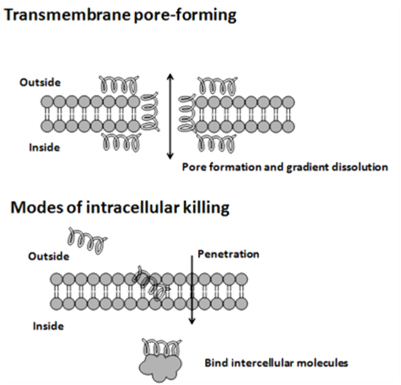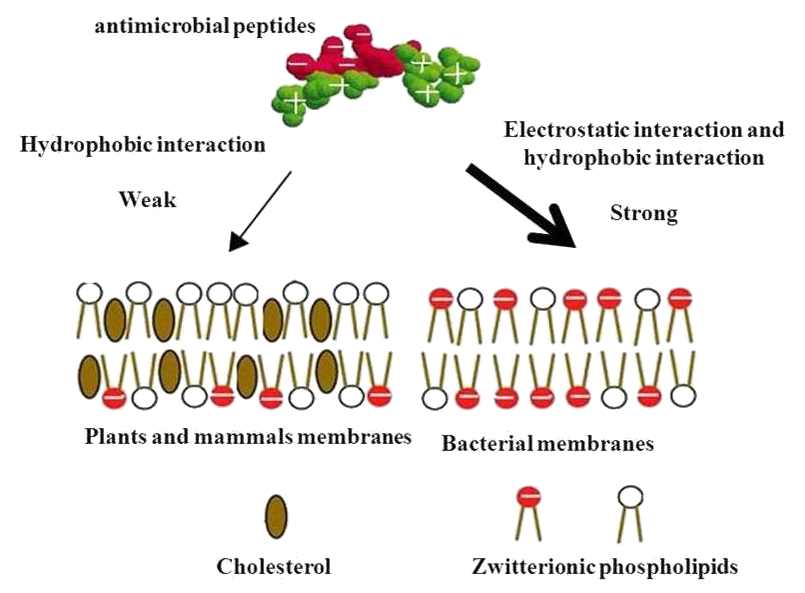Team:NYMU-Taipei/Project/Inhibition/Killing
From 2013.igem.org
| Line 5: | Line 5: | ||
<p> At first, we came up with several chemicals that might achieve our goal. Some of them are kinds of antimicrobial peptides, such as Apidaecin, [http://parts.igem.org/Part:BBa_K1104300 Abaecin], Hymenoptaecin, [http://parts.igem.org/Part:BBa_K1104301 Defensin1], which are all antimicrobial peptides in bees. Because these chemicals are secreted by bees themselves, they definitely do no harm to bees. Since we couldn’t find how to get the antimicrobial peptides, we finally decided to synthesize them by ourselves. Among four kinds of antimicrobial peptides, Apidaecin and Hymenoptaecin were much bigger so that it would be hard to synthesize, which was the first reason why we chose [http://parts.igem.org/Part:BBa_K1104300 Abaecin] and [http://parts.igem.org/Part:BBa_K1104301 Defensin1] to treat bees. The second reason was that the mRNA of Apidaecin and Hymenoptaecin couldn’t be found. In addition to antimicrobial peptides, we figured out other chemicals, which were Chitinase, Herein, Protofil, Cytochrome P450. Unfortunately, Chitinase, Herein, Protofil, and Cytochrome P450 have several defects, for example, they are all macromolecules, which make them difficult to be synthesized by E. coli. Moreover, even though E. coli successfully synthesize them, it is too hard to make these chemicals released. According to all of the above, we finally decided to use [http://parts.igem.org/Part:BBa_K1104301 Defensin1] and [http://parts.igem.org/Part:BBa_K1104300 Abaecin] to treat the bees infected by Nosema ceranae.</p> | <p> At first, we came up with several chemicals that might achieve our goal. Some of them are kinds of antimicrobial peptides, such as Apidaecin, [http://parts.igem.org/Part:BBa_K1104300 Abaecin], Hymenoptaecin, [http://parts.igem.org/Part:BBa_K1104301 Defensin1], which are all antimicrobial peptides in bees. Because these chemicals are secreted by bees themselves, they definitely do no harm to bees. Since we couldn’t find how to get the antimicrobial peptides, we finally decided to synthesize them by ourselves. Among four kinds of antimicrobial peptides, Apidaecin and Hymenoptaecin were much bigger so that it would be hard to synthesize, which was the first reason why we chose [http://parts.igem.org/Part:BBa_K1104300 Abaecin] and [http://parts.igem.org/Part:BBa_K1104301 Defensin1] to treat bees. The second reason was that the mRNA of Apidaecin and Hymenoptaecin couldn’t be found. In addition to antimicrobial peptides, we figured out other chemicals, which were Chitinase, Herein, Protofil, Cytochrome P450. Unfortunately, Chitinase, Herein, Protofil, and Cytochrome P450 have several defects, for example, they are all macromolecules, which make them difficult to be synthesized by E. coli. Moreover, even though E. coli successfully synthesize them, it is too hard to make these chemicals released. According to all of the above, we finally decided to use [http://parts.igem.org/Part:BBa_K1104301 Defensin1] and [http://parts.igem.org/Part:BBa_K1104300 Abaecin] to treat the bees infected by Nosema ceranae.</p> | ||
| + | =='''Background'''== | ||
| + | ==='''How Do AntiMicrobial Peptides Work?'''=== | ||
| + | <p> Because [http://parts.igem.org/Part:BBa_K1104300 Abaecin] and [http://parts.igem.org/Part:BBa_K1104301 Defensin1] are also AMPs, the mechanism are almost the same.</p> | ||
| + | <p> The cytoplasmic membrane is a frequent target, but peptides may also interfere with DNA and protein synthesis, protein folding, and cell wall synthesis. The initial contact between the peptide and the target organism is electrostatic, as most bacterial surfaces are anionic, or hydrophobic. Their amino acid composition, amphipathicity, cationic charge and size allow them to attach to and insert into membrane bilayers to form pores by ‘barrel-stave’, ‘carpet’ or ‘toroidal-pore’ mechanisms. Alternately, they may penetrate into the cell to bind intracellular molecules which are crucial to cell living. Intracellular binding models includes inhibition of cell wall synthesis, alteration of the cytoplasmic membrane, activation of autolysin, inhibition of DNA, RNA, and protein synthesis, and inhibition of certain enzymes. One emerging technique for the study of such mechanisms is dual polarisation interferometry. In contrast to many conventional antibiotics these peptides appear to be bactericidal instead of bacteriostatic. In general the antimicrobial activity of these peptides is determined by measuring the minimal inhibitory concentration (MIC), which is the lowest concentration of drug that inhibits bacterial growth.</p> | ||
| + | |||
| + | [[File:NYMU_Group6_AMP-1.png|500px]] | ||
| + | [[File:NYMU_Group6_AMP-2.png|500px]] | ||
| + | |||
| + | *See more [http://en.wikipedia.org/wiki/Antimicrobial_peptides http://en.wikipedia.org/wiki/Antimicrobial_peptides] | ||
| + | |||
| + | <p> After deciding the chemicals that are able to kill Nosema ceranae without harming the bees and how they work, we designed our experiment. The following is our material list as well as experimental procedure.</p> | ||
{{:Team:NYMU-Taipei/Footer}} | {{:Team:NYMU-Taipei/Footer}} | ||
Revision as of 16:35, 26 September 2013


Introduction
At first, we came up with several chemicals that might achieve our goal. Some of them are kinds of antimicrobial peptides, such as Apidaecin, [http://parts.igem.org/Part:BBa_K1104300 Abaecin], Hymenoptaecin, [http://parts.igem.org/Part:BBa_K1104301 Defensin1], which are all antimicrobial peptides in bees. Because these chemicals are secreted by bees themselves, they definitely do no harm to bees. Since we couldn’t find how to get the antimicrobial peptides, we finally decided to synthesize them by ourselves. Among four kinds of antimicrobial peptides, Apidaecin and Hymenoptaecin were much bigger so that it would be hard to synthesize, which was the first reason why we chose [http://parts.igem.org/Part:BBa_K1104300 Abaecin] and [http://parts.igem.org/Part:BBa_K1104301 Defensin1] to treat bees. The second reason was that the mRNA of Apidaecin and Hymenoptaecin couldn’t be found. In addition to antimicrobial peptides, we figured out other chemicals, which were Chitinase, Herein, Protofil, Cytochrome P450. Unfortunately, Chitinase, Herein, Protofil, and Cytochrome P450 have several defects, for example, they are all macromolecules, which make them difficult to be synthesized by E. coli. Moreover, even though E. coli successfully synthesize them, it is too hard to make these chemicals released. According to all of the above, we finally decided to use [http://parts.igem.org/Part:BBa_K1104301 Defensin1] and [http://parts.igem.org/Part:BBa_K1104300 Abaecin] to treat the bees infected by Nosema ceranae.
Background
How Do AntiMicrobial Peptides Work?
Because [http://parts.igem.org/Part:BBa_K1104300 Abaecin] and [http://parts.igem.org/Part:BBa_K1104301 Defensin1] are also AMPs, the mechanism are almost the same.
The cytoplasmic membrane is a frequent target, but peptides may also interfere with DNA and protein synthesis, protein folding, and cell wall synthesis. The initial contact between the peptide and the target organism is electrostatic, as most bacterial surfaces are anionic, or hydrophobic. Their amino acid composition, amphipathicity, cationic charge and size allow them to attach to and insert into membrane bilayers to form pores by ‘barrel-stave’, ‘carpet’ or ‘toroidal-pore’ mechanisms. Alternately, they may penetrate into the cell to bind intracellular molecules which are crucial to cell living. Intracellular binding models includes inhibition of cell wall synthesis, alteration of the cytoplasmic membrane, activation of autolysin, inhibition of DNA, RNA, and protein synthesis, and inhibition of certain enzymes. One emerging technique for the study of such mechanisms is dual polarisation interferometry. In contrast to many conventional antibiotics these peptides appear to be bactericidal instead of bacteriostatic. In general the antimicrobial activity of these peptides is determined by measuring the minimal inhibitory concentration (MIC), which is the lowest concentration of drug that inhibits bacterial growth.
- See more [http://en.wikipedia.org/wiki/Antimicrobial_peptides http://en.wikipedia.org/wiki/Antimicrobial_peptides]
After deciding the chemicals that are able to kill Nosema ceranae without harming the bees and how they work, we designed our experiment. The following is our material list as well as experimental procedure.
 "
"










